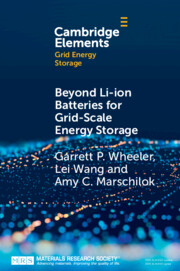Element contents
Beyond Li-ion Batteries for Grid-Scale Energy Storage
Published online by Cambridge University Press: 10 June 2022
Summary
Keywords
- Type
- Element
- Information
- Series: Elements in Grid Energy StorageOnline ISBN: 9781009030359Publisher: Cambridge University PressPrint publication: 07 July 2022
References
- 7
- Cited by

